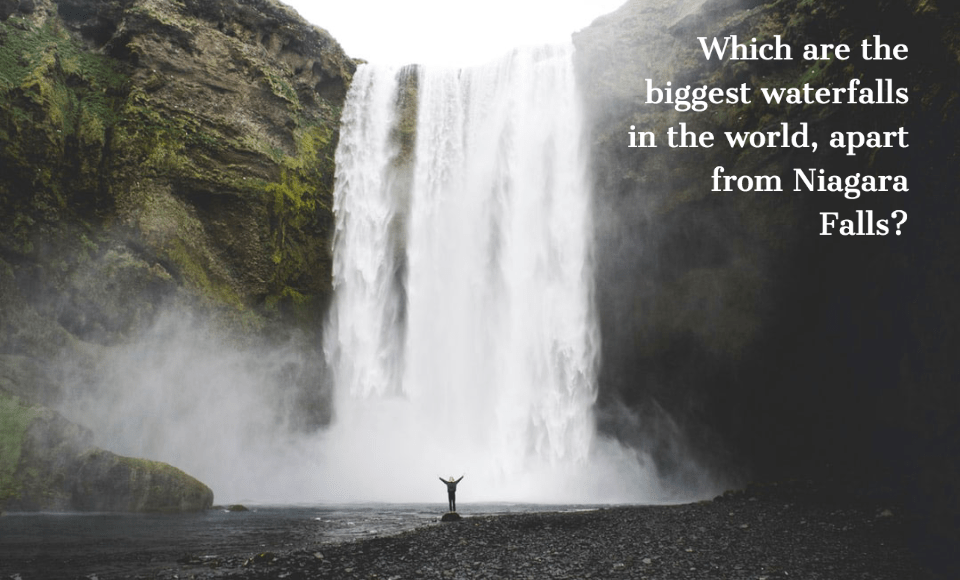Although Niagara Falls is currently the most famous waterfall of the world, but the Boyoma Falls, formerly known as the Stanley Falls, found along the Zaire River in Africa is considered the biggest waterfall in terms of volume.
By measuring the volume of the waterfall by the amount of water flowing down it in unit time, there are about 17,000 cubic meters of water that gushes down the Boyoma Falls in every second, while the Niagara Falls only has 6,000 cubic meters of water that flows over its structure. However, if you compare both the Boyoma Falls and the Niagra Falls in terms of their width, you would notice that they are not that much different.
If the size of a waterfall is going to be measured on the basis of its width, the Khone Falls on Laos’ Mekong River is the widest waterfall in the world. In regards to its height, the Khone Falls is only about 21 meters or 70 feet high, but its width is bow-shaped and is approximately 10.6 kilometers (35,000 feet). When one looks from one end of the Khone Falls, it is impossible for him or her to see the other end of the falls because of its gigantic width. Surprisingly, the average amount of water that flows down this large waterfall is close to double the volume of water that is flowing down the Niagara Falls in a single year.
The Angel Falls found in Venezuela takes the first place in the list of the tallest waterfall on Earth. The height of this magnificent work of nature is 979 meters or 3,212 feet. The amount of water that falls from that specific height is about 15 times more than what falls down on the Niagara Falls. Another interesting fact about the Angel Falls is that its name in the Pemon language is “Kerepakupai Meru,” which means “waterfall of the deepest place” in English. The Angels Falls is so high that it can even reach the lowest clouds on the atmosphere, and the clouds contribute to its angelic and ethereal appearance.
The Iguaçu Falls, which is situated on the river of the same name that is located within the borders of Brazil and Argentina in South America, also has approximately double the volume of water compared to the water falling down on the Niagara Falls. The almost deafening noise of the fall’s rapids can be heard from up to nearly 24 kilometers. But in the past, the noise of the raging waters on the falls had been completely silenced two times already in history, and these instances were caused by flooding, wherein the water level of the river had risen up to the point from where the rapids slowed down.
Nearly all the falls of the world have slowed down due to the lowering of the force of their water; however, the Victoria Falls on the Zambezi River in southern Africa has surprisingly surpassed itself. The rapids of Zimbabwe’s rivers have receded for up to 130 kilometers from their place of origin from a thousand years ago. The Victoria has a width of 1,708 meters or 5,604 feet, which makes it qualified to be one of the biggest waterfalls on Earth.
There are two countries that held the rights to the world record for having the biggest waterfall in the world, but they lost the record because of one unfortunate reason. These countries are Brazil and Paraguay, and they claimed ownership of the Guaira Falls, the waterfall that was once considered to be the number one biggest waterfall mainly due to the huge volume of water passing through it per second, which was 49,000 cubic meters. The experts on geology recognized the Guaira Falls as a natural wonder because the second biggest waterfall, the Boyoma Falls on the Zaire River, had only a third of the amount of water flowing down it compared to the Guaria Falls. But in 1982, Paraguay and Brazil built a dam right near the Guaira Falls, and the damn sadly reduced the tremendous volume of water to a mere 12,300 cubic meters. Today, the Guaira Falls is no longer considered as a real waterfall, although tourists would still visit the dam to learn more about the history of the nature-made beauty.
More reading:
- Niagara Falls (Wikipedia)
- Boyoma Falls (Wikipedia)
- Khone Phapheng Falls (Wikipedia)
- Angel Falls (Wikipedia)
- Iguazu Falls (Wikipedia)
- Victoria Falls (Wikipedia)
- Guaira Falls (Wikipedia)

